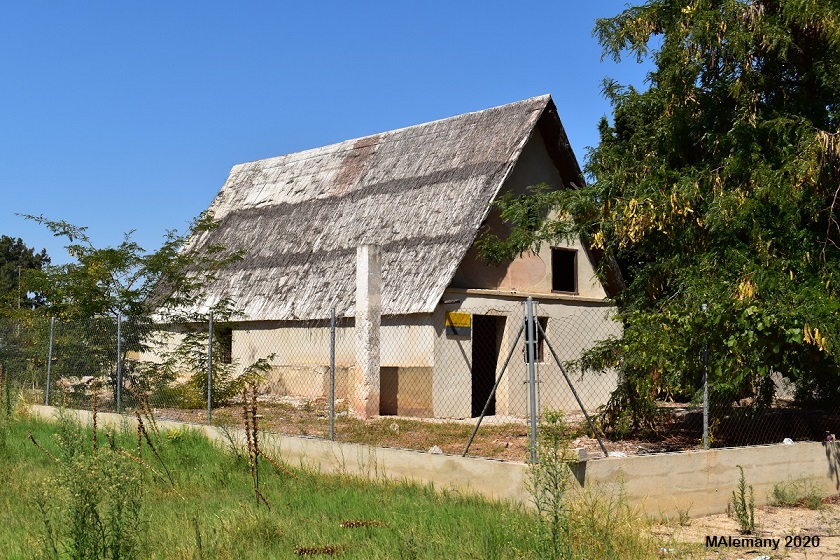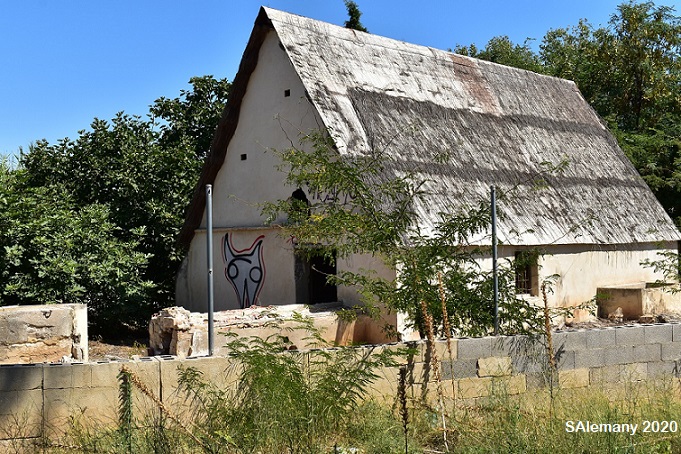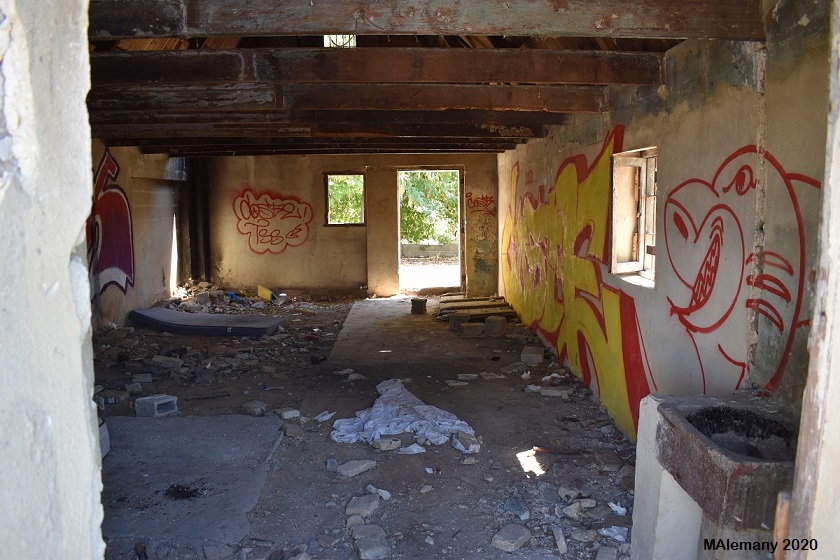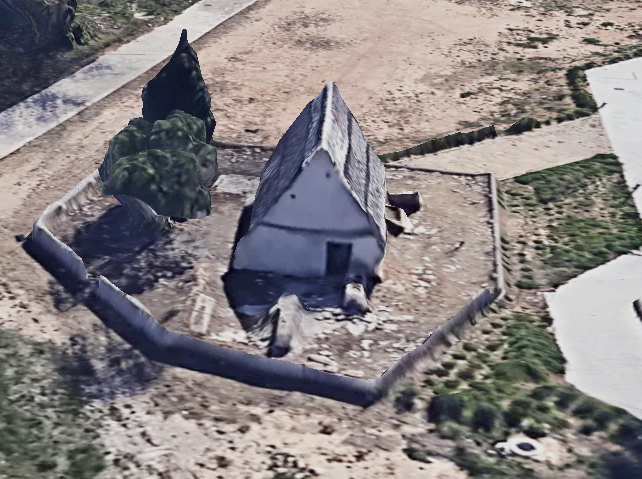
The barraca (hut) is now isolated and fenced off within the urbanised area of the Sociòpolis neighbourhood, next to the V-30 motorway towards the harbour. It used to have the address of Castell de Corbera street n.4. It can now be reached from Joan Miró street in the Sociòpolis neighbourhood.
Detail of the state of conservation: the barraca (hut) is abandoned, affected by the urbanisation process of the Sociòpolis neighbourhood. The deterioration of the building is general, although, logically, there would be no problem in restoring it.
19th century.
According to J. A. García Esparza (2012), the Barraca del Panso, also known as the Barraca de Cotofio or the Barraca del tio Tonet, is approximately two hundred years old, so it dates from the first half of the 19th century. As with many of these popular buildings in l’Horta (the irrigated land of València), it is not easy to give a more specific chronology. As in the whole of the periphery of the city of València, many of these barraques (huts) were built during the 19th or early 20th century, even with possible important modifications on the same site. These barraques do not usually appear in the documents of the past centuries in an identifiable form by names or place names, while at an oral level they were usually known in their surroundings by the name or nickname of the people who owned or lived there. For this reason, the name of the barraca (hut) was frequently modified due to the change of residence of these people, and it is difficult to determine the specific history of the owners, works, etc., without family witnesses or neighbours. As for their name, they are reasonably nicknames in the first two cases, and the proper or baptismal name in the third, of one of the owner families of the 20th century.
According to J. A. García Esparza (2012), it is built of adobe with occasional reinforcements of brick and braided cane in the gables, while the exterior has been plastered and whitewashed. The carpentry of the openings (doors and windows) was still made of wood, as is the ceiling joist. The openings (door and windows) had also undergone some modifications aimed at making them larger, and the traditional covering had been replaced by the usual corrugated fibre concrete sheets. In addition, a couple of outbuildings were attached to the barraca (hut) to increase its utility space. The ensemble was abandoned and seriously deteriorated in the early 2000s, but, as a result of the urbanisation of the new neighbourhood, it was partially restored in terms of repairing and plastering the walls, renovating the doors and windows, and replacing the roof, although also with fibre concrete sheets covered with a mesh that imitates reed. In this restoration, non-traditional materials were used, and the interior layout of the barraca was not respected, leaving it completely open-plan and without partitions. Nonetheless, the barraca has suffered progressive deterioration in recent years, becoming abandoned and unused. Doors and windows have been broken and its interior has been painted all over. As for its floor plan, it is rectangular with an area of 63.18 m2 (680ft2), a front of 5.40 m (17ft 8.5in) wide and a depth of 11.26 m (36ft 11.3in) in length, while the height is 6.30 m (20ft 8in).
- Bé Immoble de Rellevància Local (BRL-BRR), per defecte: “les barraques tradicionals de la comarca de l’Horta de València”. Disposició addicional quinta de la Llei 5/2007, de 9 de febrer, de modificació de la Llei 4/1998, de 11 de juny, del Patrimoni Cultural Valencià.
- Bé Immoble de Rellevància Local (BRL-BRR), per defecte: “les barraques tradicionals pròpies de les hortes valencianes”. Article 4 de la Llei 9/2017, de 7 d’abril, de modificació de la Llei 4/1998, del Patrimoni Cultural Valencià.
The barraca (hut) has been included in the Sol Urbà (Urban Area) of the city of València.
GARCÍA ESPARZA, J. A.(2012): Barracas del litoral mediterráneo. Catálogo de Valencia y su entorno, Castelló, Publicacions de la Universitat Jaume I, pp. 190-191.
DEL REY, M. (2010): Arquitectura Rural Valenciana, Barcelona: Galerada (1ª edició: València: Direcció General de Patrimoni Artístic, 1996).
GÓMEZ MATAIX, G. (2016): “De la esfera simbólica al catálogo arquitectónico: Atlas visual de la barraca de la Huerta de Valencia”, Revista Valenciana d’Etnologia, n. 8, pp. 115-152.
GARCÍA ESPARZA, J. A. (2008): “La barraca valenciana, procesos de transformación”, Revista Valenciana d’Etnologia, n. 3, pp. 145-159.
CRUZ OROZCO, J. (2003): “Las viviendas de cubierta vegetal en el territorio valenciano: el caso de la barraca”, Revista El Pajar: Cuaderno de Etnografía Canaria, n. 14, pp. 111-116.
SANCHIS GUARNER, M. (1957): Les barraques valencianes, Barcelona, Ed. Barcino (reedició: València, Institució Alfons el Magnànim, 1999).
ALMELA VIVES, F. (1960): La vivienda rural valenciana, Valencia, La Semana Gráfica.
CASAS TORRES, J. M. (1944): La vivienda y los núcleos rurales de la huerta de Valencia, València, Diputació Provincial de València.
RUIZ RUBIO, J. V. (1999): Construint una barraca valenciana, València, Ajuntament d’Alboraia-Col·legi d’Aparelladors i Arquitectes Tècnics de València-Col·legi d’Arquitectes de la Comunitat Valenciana.
GOSÁLVEZ, V.(1915): Estudio constructivo de la Barraca de la Vega Valenciana, Tema de investigación presentado al tribunal de oposiciones. Manuscrito. Biblioteca del COAV. València (Facsimil de: “La Barraca Valenciana”, COACV-Colegio Oficial de Arquitectos de la Comunidad Valenciana, 1998).
Photos: M. Alemany, Google Earth



















